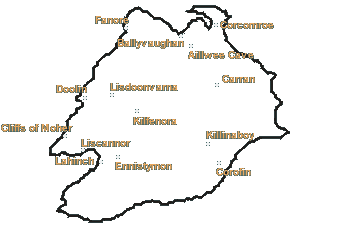
|


Caherballykinvarga
(Cathair Baile Cinn Mhargaidh - stone fort of the town
at the head of the market), 1.5 km north of Kilfenora, is an Iron Age structure of
stone built with double ring walls and a protective belt of upright stones for
good defence. Interestingly enough, the fort uses sharp limestone pillars set upright
in the ground, a devise known as chevaux de fries, as added defence. This strategy
was adopted mainly by tribes of the Iberian Peninsula (Spain and Portugal). Could
there have been contact between the two regions in the Iron Age?
Noughaval
(Nuachongbháil - new monastic settlement), 3.5 km north of Kilfenoa
is an ancient monastic site occupied up to the 19th century. The remains of
the church show that it was built and restored at different times, from the 12th to the 14th centuries.
A memorial chapel of the O'Davoren family, built in 1725 by James Davoren of
Lisdoonvarna is near by as is a holy well, Tobhar Mo Ghua.
Ballyganner Region, offers a real sense of wilderness and has 5 megalithic
tombs of varying type. There are examples of a court tomb, gallery tombs and wedge tombs.
Poulawack
(Poll an Bhaic - hole or cave of the angle or bend)  is a large cairn,
excavated by Harvard archaeologists in 1934. They found the remains of 18
people, some primitive instruments and some Bronze Age potsherds.
Caherconnell Fort, (Cathair Chonaill - Connell's fort), is a strong and
well-preserved ring fort on the Leamaneh-Ballyvavghan road. is a large cairn,
excavated by Harvard archaeologists in 1934. They found the remains of 18
people, some primitive instruments and some Bronze Age potsherds.
Caherconnell Fort, (Cathair Chonaill - Connell's fort), is a strong and
well-preserved ring fort on the Leamaneh-Ballyvavghan road.
Poulnabrone Dolmen
(Poll na Brón - hole of the quern), a magnificent portal dolmen dated from 2,500 B.C. The capstone projects forward over the entrance
or portal and the tomb is surrounded by a low circular cairn, 9m in diameter.
Gleninsheen (Gleann Insin - Glen of the little island,) stands on the slopes
of the Aillwee Mountain.
dolmen dated from 2,500 B.C. The capstone projects forward over the entrance
or portal and the tomb is surrounded by a low circular cairn, 9m in diameter.
Gleninsheen (Gleann Insin - Glen of the little island,) stands on the slopes
of the Aillwee Mountain.
It is one of the best-preserved wedge tombs in this area, famous for the
gold collar or gorget discovered nearby in 1930 by a boy hunting rabbits.
The collar was placed in the National Museum in 1934 and is recognised as
one of the finest Bronze Age artefacts we have.
Aillwee Cave
(Aill Bhui yellow cliff)
Discovered in Jack McCann, a local farmer, in 1944, the 1000 feet  long cave
is one of the oldest of the Burren Caves having formed millions of years ago.
Guided tours, lasting 30 minutes, allow you to observe beautiful caverns,
bridged chasms, underground waterfalls, weird mineral formations and the
hibernation chambers of brown bears, which have been extinct in Ireland for centuries.
Facilities include a restaurant, craft shop, information desk and outside,
'The Hazelwood' crafts village. long cave
is one of the oldest of the Burren Caves having formed millions of years ago.
Guided tours, lasting 30 minutes, allow you to observe beautiful caverns,
bridged chasms, underground waterfalls, weird mineral formations and the
hibernation chambers of brown bears, which have been extinct in Ireland for centuries.
Facilities include a restaurant, craft shop, information desk and outside,
'The Hazelwood' crafts village.
Finavarra and New Quay
Finavarra Point in Galway Bay is marked  by a Martello tower, one of the
defensive circular stone gun emplacements built during the Napoleonic wars (1800-1815). by a Martello tower, one of the
defensive circular stone gun emplacements built during the Napoleonic wars (1800-1815).
Mount Vernon Lodge at New Quay was the summer residence of the Gregory
of Coole and it is here Lady Gregory entertained W. B. Yeats and G. B. Shaw among others.
Parkmore, a short distance away, was the site of a bardic school run and
staffed by the O'Dalys, (the hereditary poets to the O'Loghlens, lords of the Burren).
There is a pillar monument to the Irish poet, Donnchadh Mor O Dalaigh.
  
|
|
















|

